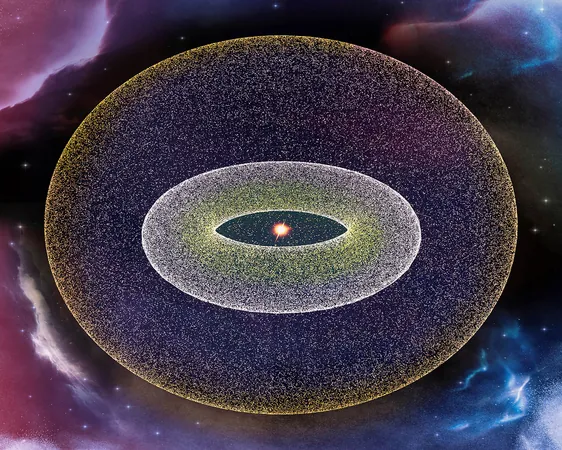
Discovering the Unexpected: A Spiral Structure at the Edge of Our Solar System
2025-03-17
Author: Wai
The vastness of our solar system extends beyond what we typically imagine. While most people picture a compact group of planets, the reality is that the neighborhood of our Sun is far more intricate and expansive. Beyond Neptune lies the famous Kuiper Belt, a region cluttered with icy remnants from the solar system's formation. However, the true frontier of our Sun's influence is far more mysterious: the Oort Cloud.
Located around 9.3 trillion miles away from the Sun, the Oort Cloud is theorized to be the outermost boundary of our solar system. This massive shell of icy objects, which still feels the Sun’s gravitational pull despite being incredibly distant, has intrigued astronomers for decades. Traditionally, the Oort Cloud has been viewed as a nearly chaotic scattering of cometary bodies, resting in relative solitude amid the expansive dark of space.
Recent research, however, has unveiled a surprising spiral structure lurking within the inner parts of the Oort Cloud, challenging our understanding of this remote region. Instead of a random scattering of icy debris, scientists discovered a well-defined spiral pattern that may reveal much about the dynamics of our solar system.
Understanding the Oort Cloud: More than Meets the Eye
To grasp the significance of this finding, we first need to understand the structure of the Oort Cloud itself. This colossal shell is generally divided into two zones: the inner and outer Oort Cloud. The inner region begins approximately 1,000 astronomical units (AU) from the Sun, while the outer region extends starting at around 10,000 AU.
Scientists posited that the outer Oort Cloud is significantly influenced by transient stars passing nearby, causing disturbances to the delicate gravitational balance, while the inner Oort Cloud is suggested to be more stable, mostly influenced by the Sun's gravity.
The Spiral Revelation
A recent groundbreaking study led by astronomer David Nesvorný from the Southwest Research Institute unveiled that the inner Oort Cloud is not as chaotic as once thought. Using simulations that spanned 4.6 billion years of the solar system's history, the research team explored how the gravitational forces from the Milky Way and the Sun shaped this region.
According to their findings, the galactic tides create a spiral structure in the inner Oort Cloud, stretching about 15,000 AU in length, equivalent to approximately 1.4 trillion miles. How astonishing to realize that this spiral might be a remnant of the forces acting on icy bodies in the solar system since its very inception! The spiral's tilt of roughly 30 degrees relative to the solar plane might be evidence of the galaxy's gravitational influence during the early days of the solar system formation.
What Implications Does This Have?
Understanding this spiral structure sheds light on the ongoing story of our solar system. These patterns may ultimately affect how comets from the Oort Cloud behave as they traverse inward towards the Sun, potentially offering insights into the nature of long-period comets and the evolution of our solar system.
Nonetheless, even with these groundbreaking revelations, directly observing the spiral remains elusive. The icy bodies residing in the Oort Cloud reflect too little light, making them nearly impossible to detect with current technology, and their slow motions stretch over vast timescales.
Nevertheless, the model's predictions align well with the behavior of faint comets that have previously been observed entering the inner solar system. This prolonged spiral seems to hint that there are intricate connections at play between our Sun and the larger Milky Way—a relationship more delicate and nuanced than we had assumed.
As more research emerges, we may soon unlock further secrets of the Oort Cloud and the mysterious forces that have shaped it. The study has been submitted for further peer review, and the exploration of our solar system’s farthest reaches continues. What other wonders may still be lurking in the cosmic shadows?




 Brasil (PT)
Brasil (PT)
 Canada (EN)
Canada (EN)
 Chile (ES)
Chile (ES)
 Česko (CS)
Česko (CS)
 대한민국 (KO)
대한민국 (KO)
 España (ES)
España (ES)
 France (FR)
France (FR)
 Hong Kong (EN)
Hong Kong (EN)
 Italia (IT)
Italia (IT)
 日本 (JA)
日本 (JA)
 Magyarország (HU)
Magyarország (HU)
 Norge (NO)
Norge (NO)
 Polska (PL)
Polska (PL)
 Schweiz (DE)
Schweiz (DE)
 Singapore (EN)
Singapore (EN)
 Sverige (SV)
Sverige (SV)
 Suomi (FI)
Suomi (FI)
 Türkiye (TR)
Türkiye (TR)
 الإمارات العربية المتحدة (AR)
الإمارات العربية المتحدة (AR)